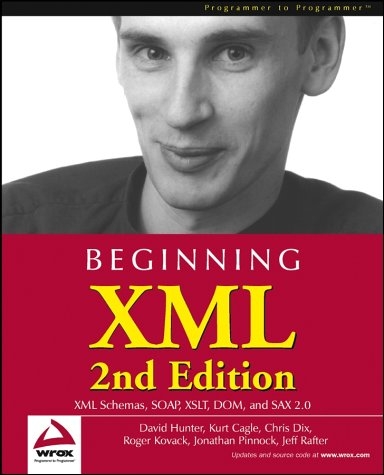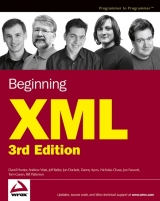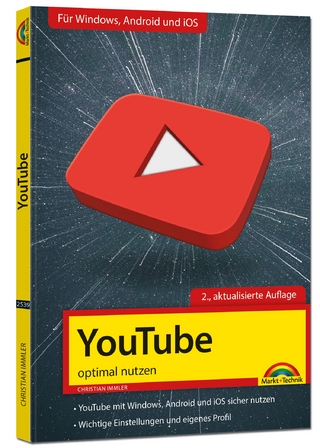
Beginning XML
Hungry Minds Inc,U.S. (Verlag)
978-0-7645-4394-4 (ISBN)
- Titel ist leider vergriffen;
keine Neuauflage - Artikel merken
* SOAP and Web Services * Displaying XML using CSS and XSL * Incorporating XML into tradition databases and n-tier architectures * XLink and XPointer for linking XML and non-XML resources Who is this book for? Beginning XML, 2nd Edition is for any developer who is interested in learning to use XML in web, e-commerce or data-storage applications. Some knowledge of mark up, scripting, and/or object oriented programming languages is advantageous, but not essential, as the basis of these techniques are explained as required.
Kurt Cagle is a writer and developer specializing in XML and Internet related issues. He has written eight books and more than one hundred articles on topics ranging from Visual Basic programming to the impact of the Internet on society, and has consulted for such companies as Microsoft, Nordstrom, AT&T and others. He also helped launch Fawcette's XML Magazine and has been the DevX DHTML and XML Pro for nearly two years. Chris Dix has been developing software for fun since he was 10 years old, and for a living for the past 8 years. He is one of the authors of Professional XML Web Services, and he frequently writes and speaks on the topic of XML and Web Services. Chris is Lead Developer for NavTraK, Inc., a leader in automatic vehicle location systems located in Salisbury, Maryland, where he develops Web Services and system architecture. He can be reached at cdix@navtrak.net. David Hunter is a Senior Architect for MobileQ, a leading mobile software solutions developer, and the first company to ship an XML-based mobility server. David has extensive experience building scalable applica tions, and provides training on XML. He also works closely with the team that develops MobileQ's flagship product, XMLEdge, which delivers the ideal mobile user experience on a diverse number of mobile devices. Roger Kovack has more than 25 years of software development experience, started by programming medical research applications in Fortran on DEC machines at the University of California. More recently he has consulted to Wells Fargo and Bank of America, developing departmental information systems on desktop and client/server platforms. Bitten by Java and the web bug in the mid '90s he developed web applications for Commerce One, a major B2B software vendor; and for LookSmart.com, one of the best known and still operating web portals. He was instrumental in bringing Java into those organizations to replace ASP and C++. Roger can be contacted on http://www xslroot.com. Jonathan Pinnock started programming in Pal III assembler on his school's PDP 8/e, with a massive 4K of memory, back in the days before Moore's Law reached the statute books. These days he spends most of his time developing and extending the increasingly successful PlatformOne product set that his company, JPA, markets to the financial services community. JPA's home page is at: www jpassoc.co.uk Jeff Rafter currently resides in Iowa City, where he is studying Creative Writing at the University of Iowa. For the past two years, he has worked with Standfacts Credit Services, a Los Angeles based company, developing XML interfaces for use in the mortgage industry. He also leads the XML development for Defined Systems, a web hosting company founded with his long time friend Dan English. In his free time, Jeff composes sonnets, plays chess in parks, skateboards, and reminisces about the Commodore64 video game industry of the late 1980s.
Introduction.; Chapter 1: What is XML?; Chapter 2: Well-Formed XML.; Chapter 3: XML Namespaces.; Chapter 4: XSLT.; Chapter 5: Document Type Definitions.; Chapter 6: XML Schemas.; Chapter 7: Advanced XML Schemas.; Chapter 8: The Document Object Model (DOM).; Chapter 9: The Simple API for XML (SAX).; Chapter 10: SOAP.; Chapter 11: Displaying XML.; Chapter 12: XML and Databases.; Chapter 13: Linking and Querying XML.; Case Study 1: Using XSLT to Build Interactive Web Applications.; Case Study 2 - XML Web Services.; Appendix A: The XML Document Object Model.; Appendix B: XPath Reference.; Appendix C: XSLT Reference.; Appendix D: Schema Element and Attribute Reference.; Appendix E: Schema Datatypes Reference.; Appendix F: SAX 2.0: The Simple API for XML.; Appendix G: Useful Web Resources.; Index.
| Erscheint lt. Verlag | 20.12.2001 |
|---|---|
| Zusatzinfo | Illustrations |
| Verlagsort | Foster City |
| Sprache | englisch |
| Maße | 187 x 230 mm |
| Gewicht | 1191 g |
| Einbandart | Paperback |
| Themenwelt | Mathematik / Informatik ► Informatik ► Web / Internet |
| ISBN-10 | 0-7645-4394-6 / 0764543946 |
| ISBN-13 | 978-0-7645-4394-4 / 9780764543944 |
| Zustand | Neuware |
| Haben Sie eine Frage zum Produkt? |
aus dem Bereich



